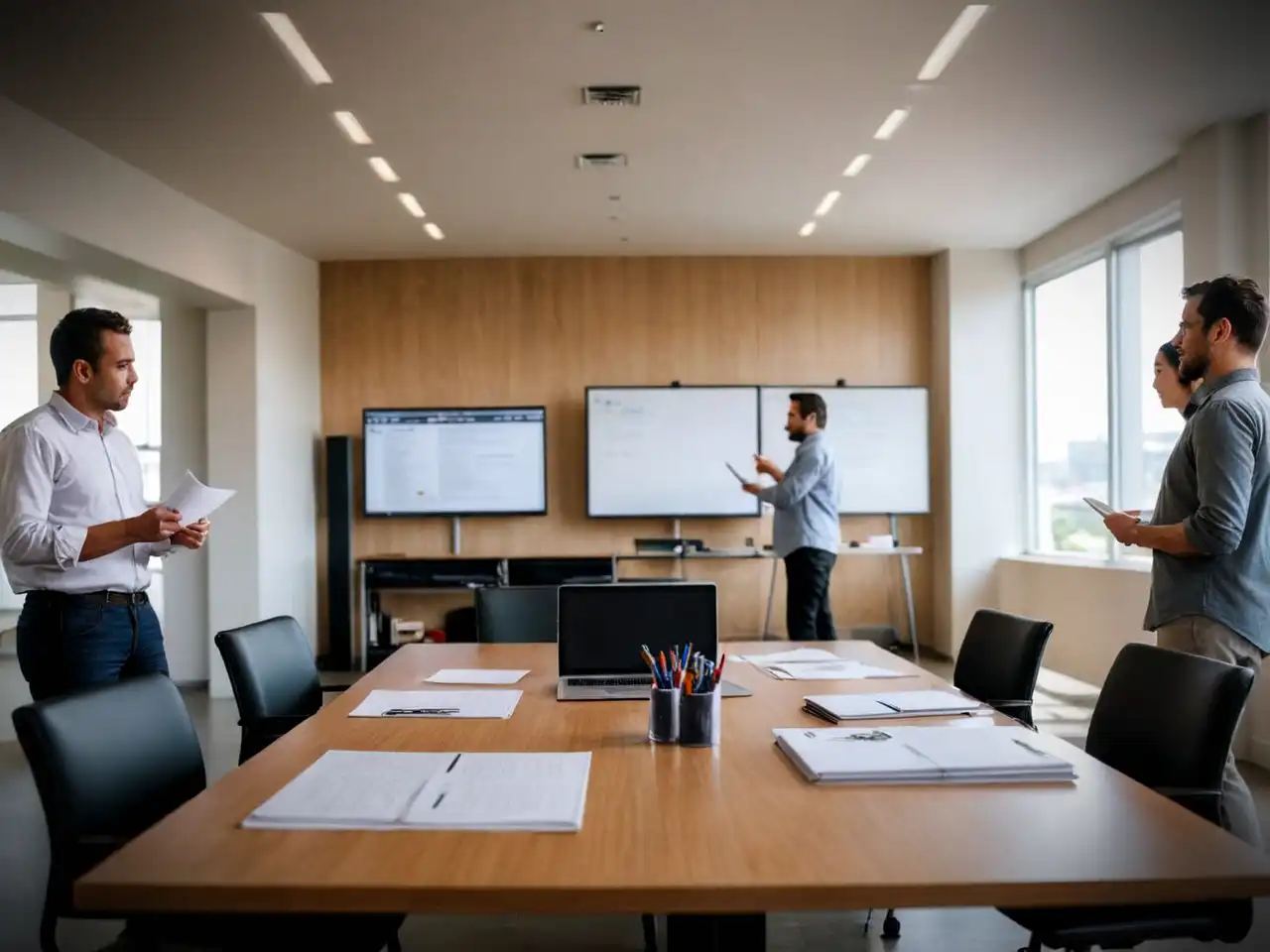Ideation Meeting
This guide will walk you through the essential elements of use ideation meeting to keep your attendees aligned and engaged.
Try Lark for Free
In a rapidly evolving business landscape, the ability to generate innovative ideas is paramount for organizational success. Hosting a successful ideation meeting is a crucial step in this process. Whether held in person or virtually, running a productive ideation session requires careful planning, facilitation, and follow-up. In this article, we will explore the intricacies of conducting a successful ideation meeting, offering valuable insights, practical examples, and tips for maximizing its impact.
Use Lark Meetings to turn meetings into true collaborative experiences.
What is an ideation meeting?
An ideation meeting is a structured gathering aimed at generating innovative ideas and solutions to specific challenges or opportunities within an organization. It serves as a platform for collaborative brainstorming and creativity, bringing together diverse perspectives and expertise to fuel innovation.
An effective ideation meeting creates an open and inclusive environment where participants feel empowered to contribute their insights and ideas. The primary goal is to explore new possibilities, identify potential opportunities, and devise creative solutions to real-world problems.
Goals of ideation meeting
The primary objectives of an ideation meeting include:
- Generating a wide array of innovative ideas.
- Encouraging cross-functional collaboration.
- Fostering a culture of creativity and innovation within the organization.
- Identifying potential solutions to specific challenges or opportunities.
By setting clear and achievable goals, an ideation meeting aims to channel the collective creativity of participants towards tangible outcomes that drive the organization forward.
Who should attend an ideation meeting?
The success of an ideation meeting hinges on the active participation of diverse stakeholders who bring unique perspectives and expertise to the table. Key participants may include:
- Cross-functional team members representing various departments or areas of expertise.
- Leadership and decision-makers who can provide valuable guidance and support for the implementation of innovative ideas.
- Subject matter experts who possess in-depth knowledge relevant to the topics being explored.
In essence, a successful ideation meeting involves the active engagement of individuals who can contribute valuable insights and collaborate on generating innovative solutions.
Learn more about Lark x Meetings
Topics, agenda, and structure of ideation meeting
The topics, agenda, and overall structure of an ideation meeting play a pivotal role in guiding productive discussions and fostering creativity. A well-crafted ideation meeting should include the following elements:
- Defined Topics: Clearly defined areas of focus or specific challenges to be addressed during the session.
- Structured Agenda: A well-organized agenda outlining the flow of activities, time allocation for each segment, and designated discussion points.
- Facilitated Environment: A conducive environment that encourages open dialogue, creative thinking, and constructive brainstorming.
- Dedicated Resources: Access to necessary resources, such as whiteboards, technology tools, or reference materials, to support the ideation process.
The seamless integration of these elements lays the foundation for a productive ideation meeting.
Learn more about Lark x Meetings
How often does an ideation meeting occur?
The frequency of ideation meetings depends on the organization's specific needs, project timelines, and the urgency of addressing particular challenges or opportunities. While some organizations may conduct ideation meetings on a monthly or quarterly basis to fuel ongoing innovation, others may arrange them in response to specific strategic initiatives or immediate business needs.
Key differences between ideation meeting and another similar meeting
An ideation meeting differs from other types of gatherings, such as brainstorming sessions or strategy meetings, in several key aspects:
- Purpose: While brainstorming sessions focus on generating a wide range of ideas, ideation meetings also emphasize the evaluation and refinement of those ideas to identify actionable solutions.
- Structured Process: Ideation meetings often follow a structured process that includes predefined agendas, facilitated discussions, and post-meeting evaluation, setting them apart from more informally structured brainstorming sessions.
- Cross-functional Collaboration: Ideation meetings typically involve cross-functional collaboration, where participants from diverse areas of expertise contribute to the ideation process, distinguishing them from strategy meetings that may predominantly involve executive-level participants.
Learn more about Lark x Meetings
Three practical examples of ideation meeting
Example 1: new product development
Example 1: new product development
In a leading consumer goods company, an ideation meeting was conducted to generate innovative ideas for new product development. The session brought together product managers, marketing specialists, and R&D experts, resulting in the identification of a breakthrough concept that eventually became a bestselling product.
Example 2: process improvement initiative
Example 2: process improvement initiative
A global manufacturing firm organized an ideation meeting focused on streamlining its production processes. The diverse team, including engineers, operations managers, and quality control specialists, collaborated to propose actionable process improvement strategies, leading to significant efficiency gains.
Example 3: market expansion strategy
Example 3: market expansion strategy
A tech startup hosted an ideation meeting to explore opportunities for expanding into new markets. By bringing together sales, marketing, and market research professionals, the company was able to develop a comprehensive market expansion strategy, ultimately leading to successful market entry.
Common pitfalls of an ideation meeting
Despite the potential for driving innovation, ideation meetings can encounter various challenges, including:
- Unstructured Discussions: Lack of facilitated discussions or undefined agendas can lead to disorganized brainstorming and unclear outcomes.
- Groupthink: The tendency to conform to prevailing opinions or ideas can hinder the generation of diverse and creative solutions.
- Lack of Follow-up: Failing to follow up on the ideas generated during the meeting can demotivate participants and diminish the impact of the session.
Learn more about Lark x Meetings
Dos and don'ts of an ideation meeting
| Do's | Don'ts |
|---|---|
| Encourage diverse participation from various departments | Dismiss ideas without proper evaluation |
| Emphasize active listening and mutual respect | Allow dominating personalities to monopolize discussions |
| Capture and document all ideas for future evaluation | Neglect to provide constructive feedback on proposed ideas |
| Facilitate structured brainstorming activities | Overload the agenda, leading to rushed or incomplete ideas |
What makes a virtual ideation meeting successful?
Successfully conducting virtual ideation meetings requires leveraging specific strategies and tools to optimize the remote collaboration experience. Key factors that contribute to the success of virtual ideation meetings include:
- Interactive Digital Platforms: Utilizing interactive digital whiteboards, collaboration tools, and video conferencing platforms to facilitate engaging and productive discussions.
- Effective Facilitation: Employing skilled facilitators who can navigate virtual dynamics, encourage participation, and maintain the focus on generating innovative ideas.
- Pre-planned Breakout Sessions: Organizing targeted breakout sessions within the virtual meeting to promote small group interactions and idea generation.
Learn more about Lark x Meetings
Typical takeaways of the ideation meeting
Following a well-executed ideation meeting, organizations can expect to gain:
- Innovative Solutions: Identification of innovative solutions to existing challenges or opportunities, contributing to organizational growth and advancement.
- Enhanced Team Collaboration: Strengthened cross-functional collaboration and a shared sense of ownership over the generated ideas, fostering a culture of innovation.
- Actionable Insights: Valuable insights and concepts that can be translated into actionable initiatives and projects, driving tangible outcomes.
Questions to ask in the ideation meeting
To stimulate creative thinking and encourage meaningful contributions during an ideation meeting, consider posing thought-provoking questions such as:
- What emerging trends or market shifts present opportunities for innovation within our organization?
- How can we reimagine our existing products/services to meet evolving customer needs and preferences?
- What potential roadblocks or challenges might hinder the implementation of proposed ideas, and how can we address them proactively?
Learn more about Lark x Meetings
Conclusion
In essence, hosting a successful ideation meeting in 2024 involves proactive planning, fostering inclusive participation, and structured facilitation to drive the generation of innovative ideas. By emphasizing the value of diverse perspectives, effective collaboration, and actionable outcomes, organizations can harness the full potential of ideation meetings to fuel continuous innovation and growth.
Use Lark Meetings to turn meetings into true collaborative experiences.
A Game Changer for Ideation Meeting: Empower your team with Lark Meetings
In the fast-paced and dynamic world of modern business, effective communication and collaboration are crucial for success of Ideation Meeting. Here we introduce Lark Meetings to serve as a centralized hub for all communication needs.
Transform your meetings into collaborative endeavors

Leverage the potency of in-call document sharing, intelligent meeting minutes, and mobile-optimized features to enhance productivity collaboratively, irrespective of your location or schedule.
Seamlessly collaborate in real-time, across any device

Share live documents instead of just screen views. Participants can navigate and edit simultaneously within the video call window, even while on the move.
Shift your focus to engagement, not note-taking

Lark Minutes automatically converts video meetings into transcripts, facilitating easy viewing, searching, and collaborative editing. Stay in the loop asynchronously, even if you can't attend the live meeting. Lark Minutes for meeting minutes support translation into 10+ different languages.
Break language barriers in communication

Lark Meetings provide real-time translation for subtitles, allowing individuals from diverse backgrounds to express themselves in their native languages. Ensure every voice is heard, regardless of geographical location. Live subtitles currently support translations from English, Chinese, and Japanese to 10+ different languages. See more translation feature in Lark.
Connect with larger audiences
Host dynamic online meetings and events accommodating up to 1,000 participants, with the flexibility of up to 50 breakout sessions for intimate group discussions within the larger meeting context. Try more Lark features for free.








